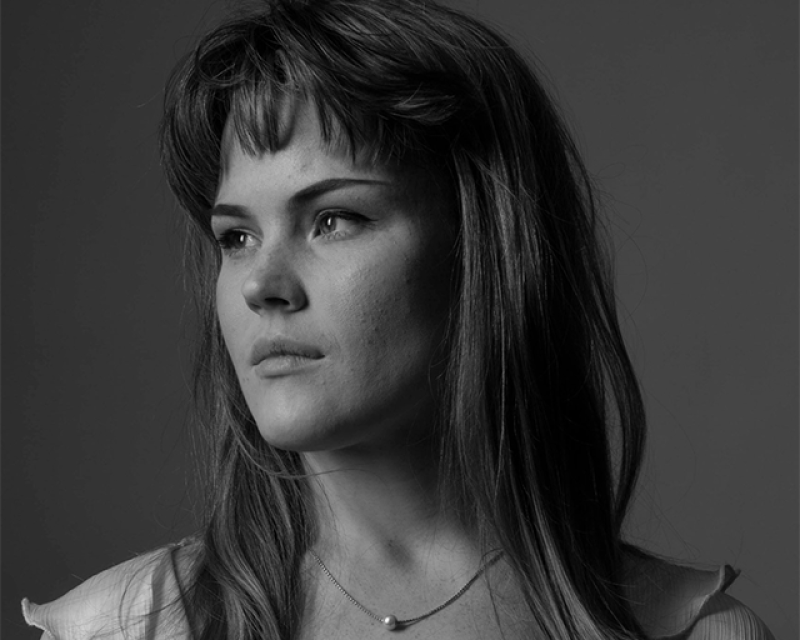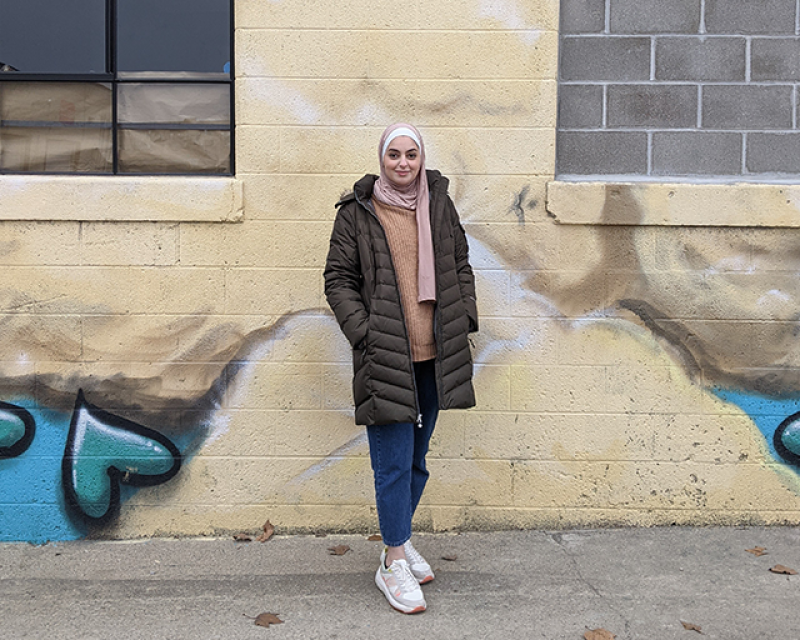Lydia Simon helps Columbus artists reach new heights at Wild Goose Creative


Photo by Hiroshi Hayawaka.
Lydia Simon has been immersed in creativity since she was a child. Her dad is a jazz violinist and a fine arts professor in Cleveland, while her mom, formerly the lead soprano of the Cleveland Opera, is a vocal coach for the Baldwin Wallace theater program.
With two artists for parents, Simon inevitably became acquainted with the life of professional performers and creators.
“I grew up in an environment surrounded by art, so it's an environment that I feel really at home in but also challenged in,” Simon said. “It makes me feel alive.”
Simon knew from a young age she wanted to pursue a career in the arts, but she also knew she didn’t want to be a professional artist. Instead, she wanted to carve a path that distinguished her from her parents.
With that dream in mind, Simon went on to pursue a BA in arts management and a master’s in Chinese language and culture from Ohio State. Now, as executive director of Wild Goose Creative, Simon leads an organization at the forefront of shaping Columbus’ creative culture and identity.
Wild Goose Creative is a nonprofit community arts organization that’s been a part of Columbus since 2008. It’s all about providing space and resources for Columbus creatives; if someone has an idea, whether that’s for a fashion show or art exhibit, Wild Goose helps make it happen.
“We just love to say yes to creatives and provide opportunities to really help grow their careers and their networks,” Simon said. “We’re also committed to providing accessible arts experiences for the community at a very low cost.”
Wild Goose's December gallery show, Fabricated Magic, was a collection of works by Avery McGrail, '18 BFA, centered around the "magical healing plushness of textile art."
Simon stumbled across the arts management major, offered through the Department of Arts Administration, Education and Policy, when she was a sophomore in college. The program allowed her to take classes in entrepreneurship, accounting, policy and nonprofit management, and she realized she would be able to utilize her relationship-building skills and other talents to work in the arts.
“I fell in love with arts management because it gave me a bit of stability, which is really important to me, and I could be in the environment that I knew that I wanted to be in,” Simon said.
Loulwa Alkaisi, an Ohio State senior and a spring intern at Wild Goose Creative, found her way to arts management through similar interests.
“When I graduated high school, I was living in Dubai, and I knew that I wanted to do something in art,” she said. “But I didn't want to do fine art.”
At first, Alkaisi thought maybe architecture would be a good fit, but once she realized it didn’t make her happy, she decided to take a gap year and work for a family member’s art gallery. The experience convinced her that arts management was the right field, and she enrolled in the program at Ohio State.

Loulwa Alkaisi outside Wild Goose Collective's new location in Franklinton. Photo courtesy of Lydia Simon.
Through the arts management major, Alkaisi was required to complete an internship before graduating, and she was drawn to Wild Goose because of its focus on varied programming and support of local artists. The internship, Alkaisi said, has helped her apply what she’s learned in the classroom to the professional world. She’s been able to assist Simon with grant writing, marketing and a range of other responsibilities she hopes will prepare her for a career in arts management.
Ohio State Arts Scholars Program Manager Roman Suer, who also sits on Wild Goose’s Board of Directors, said internships like those offered through Wild Goose are valuable for students because they help transfer content or concepts from the classroom to real-world settings. They also present an opportunity for students to navigate the complex areas of communicating and accomplishing evolving tasks in a work environment, which can be key in preparing for graduate school or jobs. Alkaisi found that out firsthand.
“Just being out of your comfort zone, when you’re actually doing the work, you can learn a lot more,” Alkaisi said.
Suer first worked with Wild Goose Creative in the spring of 2019 for the Arts Scholars Spring Showcase, one of the program’s signature events. He said its “lovely and intimate space” served as the venue for a cabaret-style performing arts event.
Since then, he’s co-headed Wild Goose’s monthly Business of Art series, securing speakers and themes for a program designed to provide artists with skills that can help them succeed as arts professionals.
“Lydia has been a shining example of leadership and perseverance during challenging times,” Suer said. “Based on my experiences working with her, she is highly successful at balancing the need to maintain existing partnerships while evolving her outreach to better serve her community.”
For Simon, stepping into the role of executive director was a crash course in running an organization like Wild Goose. But she’s been able to rely on the lessons she learned from her undergraduate and graduate studies to lead Wild Goose through an especially difficult time.
I fell in love with arts management because it gave me a bit of stability, which is really important to me, and I could be in the environment that I knew that I wanted to be in,” Simon said.
On one hand, her arts management degree gave her the practical skills and foundation in business to helm a growing organization. She found the major’s emphasis on entrepreneurship particularly advantageous, as working for Wild Goose showed her a new side of the arts world: often, creatives need to be innovative as they build their own businesses.
“The more and more that I am in this role as executive director, the more and more I feel like I am an entrepreneur because I wear so many hats all the time,” she said.
On the other hand, alongside her arts management degree, Simon also studied Chinese. She picked up the language as a freshman in high school, and it became a creative outlet she felt was practical and unique. After undergrad, Simon pursued a master’s in advanced Chinese language and culture through Ohio State and Peking University, living for a year in Beijing.
“My experience doing a master's in Chinese is probably the best thing I ever did for myself, even though I am not doing anything right now related to Chinese,” Simon said.
Beyond learning the language itself, studying Chinese gave her grit. Now, when she’s facing a particularly difficult challenge — like maintaining an organization during a pandemic that has relied heavily on in-person programming — she thinks about how she wrote an 80-page thesis in Chinese, and it gives her the tenacity to tackle any problem.
Simon sees arts management as supporting creatives from two angles. For those who don’t want to be professional artists, it presents a path to be a part of and support the creative community. For those looking to make a living from their art, it provides them with skills to create a successful business.
“A lot of times students don't necessarily look at their art as a product, but sometimes, depending on your goal, you might want to do that because you are an entrepreneur,” Simon said.
The world has also changed for artists, making it easier for them to sell their art and build client bases on their own, Alkaisi said.
“It’s very important for artists to have the opportunity to learn about arts management today because the artist doesn't really need someone to help him get his art out there if he knows what he's doing,” Alkaisi said. “There are now a lot of different ways artists can apply those skills to do it for themselves.”
That entrepreneurial spirit is something that defines the Columbus arts scene and the city more broadly, Simon said. She believes artists and creatives will be a vital component of Columbus growing into an even more vibrant community as the city looks to the future. It’s already an important part of the area’s economic development; in 2017, the Greater Columbus Arts Council reported that the nonprofit arts and culture sector is a $412.3 million industry in the greater Columbus area.
Suer agrees, saying the arts have the ability to connect people of diverse backgrounds across mediums that reveal shared humanity or experiences.
“The arts play a significant role in civic engagement because of their ability to communicate and realize stories or issues in an emotionally resonant and sometimes urgent manner,” Suer said. “We’ve seen powerful art created during recent efforts to combat social injustices right here in Columbus.”
Helping artists tell the dynamic stories of Columbus is particularly exciting right now, Simon says, as Columbus is stepping into its potential and discovering what makes it unique.
“People like to live in a city that has culture because it provides a source of pride,” Simon said. “Where there is a strong community of artists, there's a strong community of arts and culture, which any flourishing city needs to have. Not only does it help tell the story of Columbus, but it also provides people opportunities to experience culture in their city, so it really does develop pride of place.”
